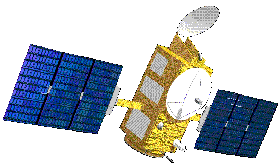
Jason-1
Jump to: Mission Objectives, Mission Instrumentation, Mission Parameters, Additional Information
Mission Photos:
 Courtesy of NASA |
" target="_blank"> Courtesy of " target="_blank">JPL |
Mission Objectives:
Jason is an oceanography mission to monitor global ocean circulation, discover the tie between the oceans and atmosphere, improve global climate predictions, and monitor events such as El Nio conditions and ocean eddies. The Jason satellite, a joint France/USA mission, is a follow-on to the highly successful TOPEX/Poseidon altimeter mission.
Jason is named after the mythological hero who led the Argonauts on the search for the Golden Fleece. "Jason" symbolizes both the hard-fought quest for a worthy goal and civilization's fascination with the ocean and its mysteries. The specification of "1" attests to the expectation that "Jason" is one of a series of TOPEX/Poseidon follow-on missions.
Mission Instrumentation:
Jason-1 has the following instrumentation onboard:
- Microwave radiometer
- DORIS dual frequency system receiver
- Dual-frequency solid-state altimeter
- GPS receiver
- Retroreflector array
Mission Parameters:
| Sponsor: | NASA & CNES |
| Expected Life: | 5 years |
| Primary Applications: | oceanography and climate change |
| Primary SLR Application(s): | calibrate satellite altimeter |
| COSPAR ID: | 0105501 |
| SIC Code: | 4378 |
| Satellite Catalog (NORAD) Number: | 26997 |
| Launch Date: | December 07, 2001 |
| RRA Diameter: | 16 cm |
| RRA Shape: | hemispherical |
| Reflectors: | 9 corner cubes |
| Orbit: | circular |
| Inclination: | 66 degrees |
| Eccentricity: | 0.000 |
| Perigee: | 1336 km |
| Period: | 112 minutes |
| Weight: | 500 kg (fueled) |
Additional Information:
Web sites:
- Jason Vibration Testing photo (JPEG, 264 Kb)
- JPL
- Archiving, Validation and Interpretation of Satellite Oceanographic data (AVISO)
- Weekly HTSI Tracking Reports
Publications:
- Haines, B., Desai, S., Willis, P., Bertiger, W., Munson, T., "Precise orbit determination for Jason-1: GPS and the 1-cm challenge", EGS-AGU-EUG Joint Assembly, Abstracts from the meeting held in Nice, France, 6 - 11 April 2003.
- Luthcke, S.B., et. al., "The 1-Centimeter Orbit: Jason-1 Precision Orbit Determination Using GPS, SLR, DORIS, and Altimeter Data", Marine Geodesy, 26: 399-421, 2003.
- Jason-1/2 SLR Tracking Status (09/2008)




